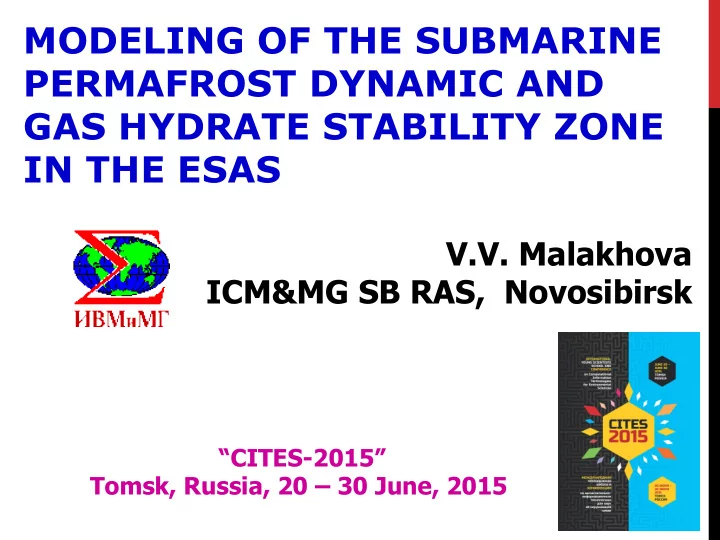

MODELING OF THE SUBMARINE PERMAFROST DYNAMIC AND GAS HYDRATE STABILITY ZONE IN THE ESAS V.V. Malakhova ICM&MG SB RAS, Novosibirsk “CITES-2015” Tomsk, Russia, 20 – 30 June, 2015
What is methane hydrate? Wh n A gas hydrate is a crystalline solid. This it is similar to ice, except that the crystalline structure is stabilized by the guest gas molecule within the cage of water molecule n Water molecules form the cage-like structure and methane molecules are contained in it 1 m ³ of methane hydrate dissociates to approximately 160 – 170 m ³ (at 0ºC and 1 atmosphere) of methane gas
Hy Hydr drate te dissocia dissociation tion Climate change alters ocean Mechanism for sea-level rise to temperature (and geothermal destabilize hydrate gradient) 100 m Global warming may cause hydrate destabilization through a rise in ocean bottom water temperatures. The increased methane content in the atmosphere in turn would be expected to accelerate warming, causing further dissociation, potentially resulting in run away global warming
Ar Arctic ctic Shelf Shelf Seas Seas host host subsea subsea per permafr mafrost ost regions gions Methane hydrates are predicted along the slopes of the shelf [Soloviev et al., 1987] Stability of sub-sea permafrost is key to stability of n 80% of the total area of sub- sea permafrost-related hydrate permafrost (shown in lilac) is in the deposits ESAS;
Methane plumes have been observed in the the ESAS ESAS Surface and Bottom water methane concentration in the ESAS as reported by Shakhova et al. [2010a] Observational data suggest >80% of the ESAS sea floor serves as a source of methane to the water column and the atmosphere
n Drilling of subsea permafrost in the Laptev Sea Region: distribution (M. Grigoriev , 2014)
Temperature comes to 0°C ( M. Grigoriev , 2014 )
Numerical Numerical models models Ø 3D World Ocean Circulation Model of ICMMG based on z-level vertical coordinate approach (Golubeva and Platov,2007, Голубева ,2008) Ø Ice model-CICE 3.0 (elastic-viscous-plastic) (W.D.Hibler ,1979; E.C.Hunke, J.K.Dukowicz,1997; G.A.Maykut 1971 C.M.Bitz, W.H.Lipscomb 1999,J.K.Dukowicz, J.R.Baumgardner 2000, W.H.Lipscomb, E.C.Hunke 2004 ) Ø Atmospheric data from the NCEP/NCAR reanalysis Ø The IAP RAS permafrost model [ Аржанов М . М ., Елисеев А . В ., Демченко П . Ф . и др ., 2008 ] Ø The Paleogeographic Scenario for subsea permafrost Ø P-T relationships hydrate stability Ø Map of investigated area «HydrateResSim» including bathymetric data [Reagan M. T., Moridis G. J., 2008 ]
Sea le Sea level and air temper el and air temperatur ture e re reconstruction over the last glacial cycle A sea level curve (based on the models) determines the time interval for inundation in the ESAS T ⎧ BW T = ⎨ B T T + Δ ⎩ A Pal Petit J.R., 1999 Climate and atmospheric history of the past 420,000 years from the Vostok ice core, Antarctica
Bauch H.F. et al.Chronology of the Holocene transgression at the Northern Siberia margin // Global and Planet. Change, 2001, vol. 31, p. 125–139.
Models of sub-sea permafrost evolution
Pore water salinity Increasing concentration of dissolved salts in the soil depresses the freezing point of the pore water. This phenomenon is important wherever pore water is saline and may be particularly significant in D=10 –9 м 2 / с controlling ice-bonding of coastal ( С . О . Разумов и др ., 2014) sediments.
Near-bottom water warming in the Arctic 1950-2012
MODELING MODELING RESUL RESULTS: TS: Time history of sediment temperature
Phas hase e trans ansit itions ions bet between een frozen en and and thaw hawed ed zone one The salinity field greatly influences the evolution of submarine permafrost. Dissolved solutes depress the freezing temperature for water
Sub-sea permafrost dynamics As water SIMULATED temperature LOCATIONS rises, the top OF THE TOP boundary BOUNDRY moves down THE PERMAFROST THICKNESS
P-T relationships q « HydrateResSim» [Reagan M. T., Moridis G. J., 2008 ]
GAS GAS HYDRA HYDRATE TE Sta Stability bility zo zone Arctic shelf hydrate formation: Cold climate epoch Time history of methane hydrate stability zone in regions of continuous permafrost at the ESAS. Localized methane releases from hydrates
Model odel loca locations ions of of met methane hane hy hydr drates es Gas Hydrate Stability Zone Gas Hydrate Stability Zone: upper boundary
V.V. Malakhova, E.N. Golubeva Modeling of the dynamics subsea permafrost in the East Siberian Arctic Shelf under the past and the future climate changes Proceedings of SPIE. 9292, 2014 А . В . Елисеев , В . В . Малахова , М . М . Аржанов , Е . Н . Голубева , С . Н . Денисов , член - корреспондент РАН И . И . Мохов Изменение границ многолетнемёрзлого слоя и зоны стабильности гидратов метана на арктическом шельфе Евразии в 1950-2100 гг . ДАН . 2015. ( в печати )
Summary Ø Increasing temperature of the bottom waters can result in the thawing of the frozen bottom sediments. Ø Based on this numerical study, hydrate deposits should also be stable within and below intact continuous permafrost layers. Ø The fact that the MHS zone is not expected to change for several thousands of years after submergence, indicates its resilience. Ø Because of their shallow depth, permafrost-associated methane hydrate deposits along the Arctic continental shelf are much more susceptible to climate change and warming than deep oceanic hydrates. Ø Continuing studies on permafrost-associated gas hydrate reservoirs will allow us to better understand the Arctic's contribution to the global methane budget and global warming
Recommend
More recommend